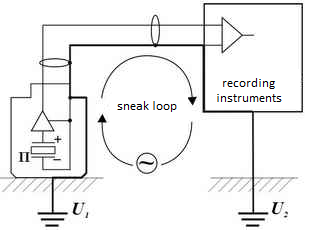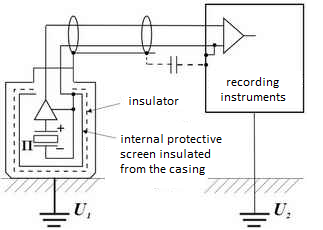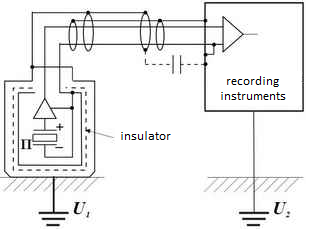Vibration Transducers Power Supply Requirements
Power supply and signal transmission in vibration transducers with IEPE-type built-in preamplifier uses a two-wire communication line. The power device must provide 2 to 20 mA power to IEPE preamplifier at 15 to 30 VDC and connection of vibration transducer to registering equipment through a coupling capacitor with capacitance ≥10 mF × 35 V for separating useful signal from 8 to 13 V direct component. The power device must contain a current-stabilization diode as current source, e.g. J511. Current value depends on connecting cable length (capacitive load) and vibration transducer operation conditions. At ambient temperature t >100°C, when a heat dissipation factor affecting amplifier’s transmission coefficient is important, power current must not exceed 6 mA.

If there is no power supply unit meeting requirements above in the registering equipment, connect vibration transducers to the registering equipment through the power unit or cable sealing boxes. Use of cable sealing boxes reduces impact of transient processes during the channel switch on measurement results in the low-frequency region. To use other power supply circuits of vibration transducers with built-in electronics please consult with the manufacturer.
Requirements for Connection Cables
Mounting of connection cable is one of the most important aspects of vibration transducer installation on the object under control. Pay special attention to three key aspects: cable length, choice of mounting direction and grounding.
Cable Length (Capacitive Load)
Long connection cable (capacitive load) on the vibration transducer preamplifier output limits output voltage amplitude in high-frequency section.
For operating the vibration transducer within the specified amplitude range, the power device must provide DC power defined as follows:
IП ≥ 2π·U·f·CO·L, where
U — input signal range, V;
f — maximum frequency value in the operating frequency range, Hz;
CO — running meter capacitance of connection cable, pF/m;
L — connection cable length, m;
For example, if voltage signal range is U = 10 V, at the frequency range to 10 kHz, running meter cable capacitance CO = 100 pF/m and length L = 100 m the IП power current must be not less than 6 mA.
Choosing Cable Mounting Direction and Electromagnetic Interference
Portable radio stations, power buses, and even electrostatic spark discharges can produce an interference signal. The correct choice of cable mounting direction will minimize the interference signal. Connection cables must not pass along AC power buses. Cables must cross AC power buses at an appropriate angle. In addition, cables must be laid to the direction opposite to radio transmitting devices, engines, generators, and transformers.
Cable Grounding and Sneak Circuits with Ground Return
To prevent interference signals caused by sneak currents flowing through ground buses of the objects under control and registering equipment, pay special attention to cable grounding based on the diagram of connecting vibration transducer to registering equipment.

Sneak circuit as a result of improper grounding
Sneak circuit with the short circuit through the ground bus appears when the common bus “vibration transducer — registering equipment” is grounded in two points with different electric potentials.
Taking into consideration possibility of sneak circuits formation it is recommended to use vibration transducers with external electrical body insulation (e.g AR2019 or AR2031) or use insulating pins – AH01005.
No sneak circuits may appear in the vibration transducers with sensing element and a built-in amplifier electrically insulated from the body (AR28, AR35 with or without metal hose).
The connection circuit of vibration transducers AR28, AR35 (without metal hose) uses a shielded 2-wire connection cable. The shield is used for protecting vibration transducer against ESD and electromagnetic interferences. The shield must be grounded only at one point, typically on the sensor body. Installation of a capacitor with capacitance ≈ 0,01 mF x 200 V between the shield and registering equipment also leads to a reduction of high-frequency interference.

Multi-wire connection circuit with one protective shield
In the case of a high level electromagnetic interference (for example, radio transmitter, electrostatic discharge, sparking), it is reasonable to use vibration transducers AR28, AR35 with a metal hose as a second external protective shield. The external protective shield is electrically connected to the vibration converter body. The internal shield electrically insulated from the external shield is connected to the registering equipment body.
Similarly to the connection scheme of vibration transducer with one protective shield, it is recommended to install capacitor with capacitance 0.01 mF x 200 V between internal and external shields.

Multi-wire connection circuit with two protective shields
